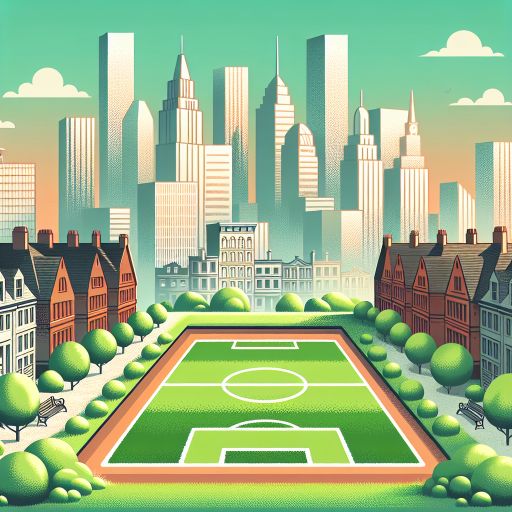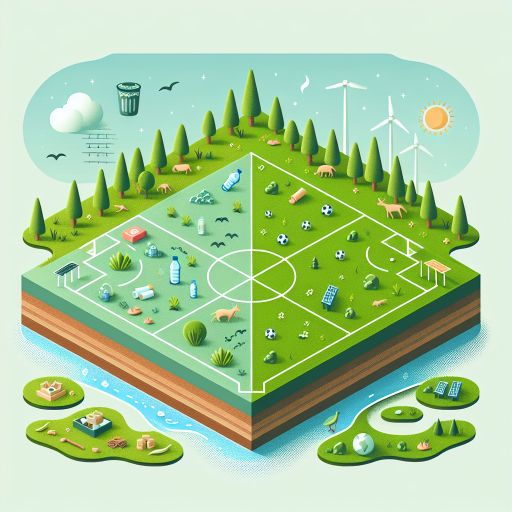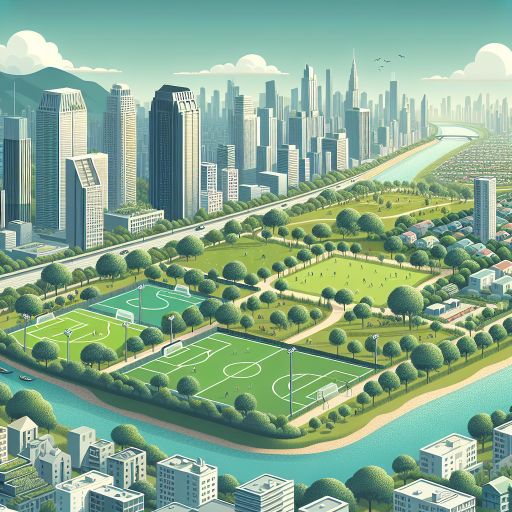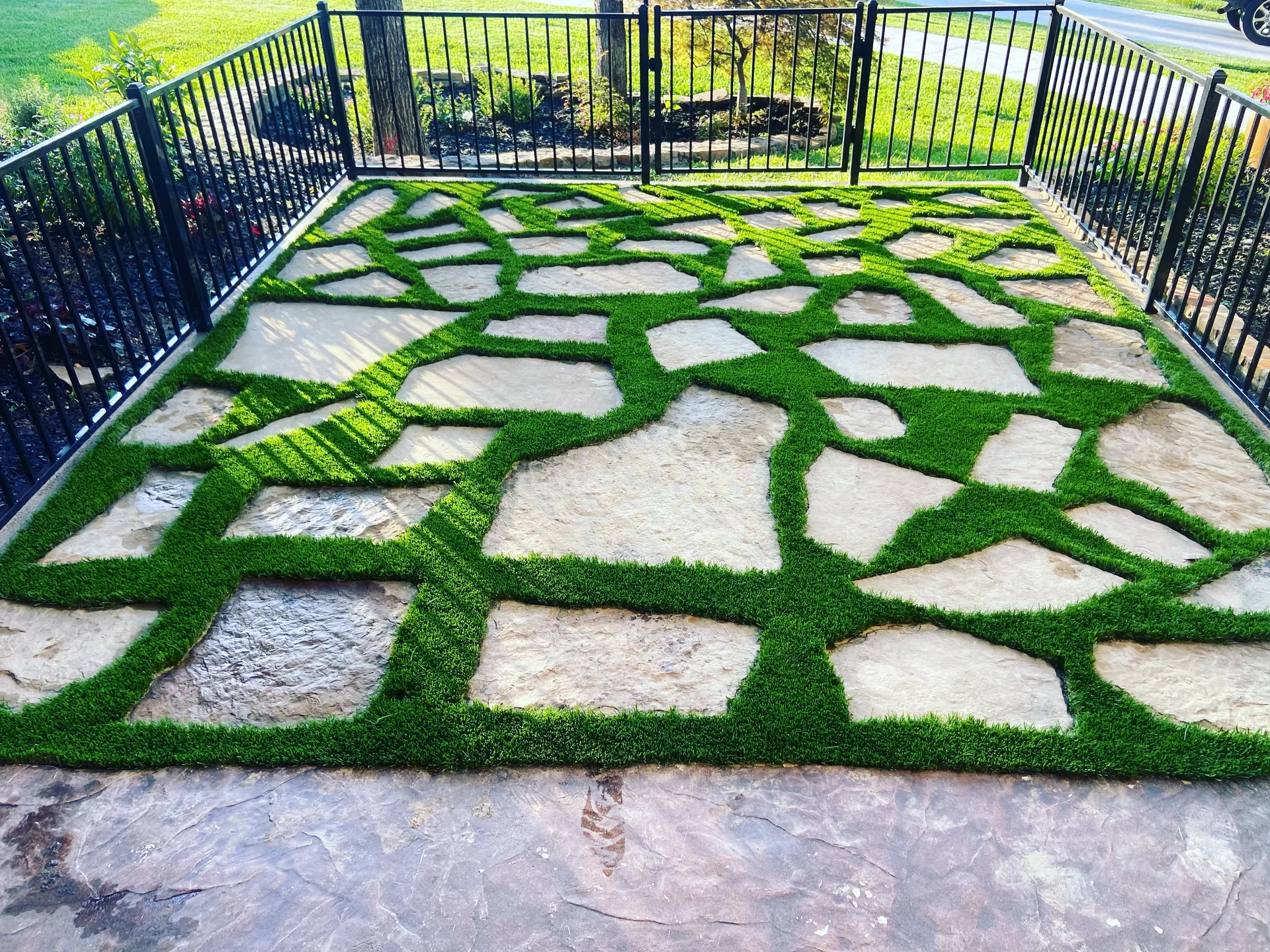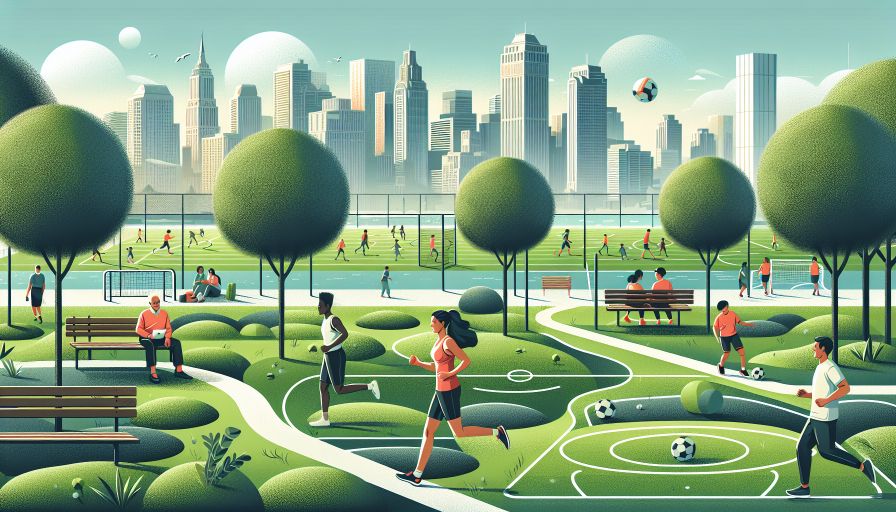
- Introduction to Artificial Turf and Urban Green Spaces: Historical Context and Evolution
- Technological Innovations in Artificial Turf Materials
- Environmental Impact and Sustainability of Artificial Turf
- Health and Safety Considerations for Urban Communities
- Economic and Maintenance Benefits of Artificial Turf for Public Spaces
- Case Studies of Artificial Turf in Urban Green Spaces Around the World
- Future Prospects: Emerging Trends and Research in Artificial Turf
Introduction to Artificial Turf and Urban Green Spaces: Historical Context and Evolution
Artificial turf, a synthetic alternative to natural grass, has gained significant popularity in urban environments over the past few decades. Initially developed in the 1960s, it was first used in sports fields, with the Houston Astrodome being one of the pioneering installations. The term “AstroTurf,” originating from this venue, has often been synonymous with artificial grass despite numerous advancements and variations since its inception.
In the historical context, the development of artificial turf aimed to provide a robust, low-maintenance alternative to natural grass, which often required intensive care, particularly in high-traffic areas. With urbanization on the rise, city planners and developers began to seek sustainable solutions to replace or complement natural greenery in urban settings. The initial generations of artificial turf, primarily composed of short-pile fibers and inflated with sand, met these needs but had numerous shortcomings, including a hard surface and limited aesthetic appeal.
Over time, innovations have dramatically transformed artificial turf, making it nearly indistinguishable from natural grass. Modern iterations feature a blend of polyethylene and polypropylene fibers that offer improved durability, softness, and aesthetic similarities to natural grass. The inclusion of infill materials such as crumb rubber and sand helps enhance the cushioning and stability of the turf, addressing earlier concerns about safety and comfort.
Urban green spaces, critical for community well-being, have witnessed a transformative evolution with the advent of artificial turf. Cities worldwide face challenges of limited space and the need for sustainable, low-maintenance solutions. Artificial turf provides an alternative that allows for the creation of visually appealing, functional green spaces in areas where maintaining natural grass is impractical.
From public parks to rooftop gardens and school playgrounds, artificial turf has become an integral part of urban planning. Its ability to withstand various weather conditions and heavy usage makes it an attractive choice for municipalities aiming to enhance urban landscapes without the extensive upkeep associated with natural grass.
The history and evolution of artificial turf reflect broader trends in urban development and environmental management. Continuous research and technological advancements have not only improved the quality and functionality of artificial turf but have also expanded its applications in urban green spaces. As cities strive to balance ecological sustainability with community well-being, artificial turf stands out as a versatile and effective solution.
Technological Innovations in Artificial Turf Materials
The development of artificial turf has seen substantial technological advancements over the past few decades. This progress has focused on improving the material composition, durability, and functionality of artificial turf, making it a viable alternative to natural grass in urban green spaces.
Advancements in Fiber Technology
One significant innovation in artificial turf materials is the development of advanced synthetic fibers. Early versions of artificial turf utilized nylon, which was durable but abrasive. Modern artificial turfs are predominantly made from polyethylene and polypropylene, which are softer and more natural in appearance.
Manufacturers have also developed mixed polymer systems that combine different fibers to enhance performance. For example, polyethylene fibers are often used for their softness, while polypropylene fibers add strength and resilience.
Improved Infill Materials
In traditional artificial turf, rubber crumb infill was commonly used to provide cushioning and support. However, concerns over health and environmental impacts have driven the development of alternative infill materials. Contemporary infill options include:
- Silica Sand: Provides stability and allows for better drainage.
- Cork: A natural and eco-friendly alternative offering good shock absorption.
- Coconut Husk: Another organic option that contributes to cushioning and moisture regulation.
- Thermoplastic Elastomers (TPE): A non-toxic synthetic infill that can be recycled.
Backing Systems and Drainage
The backing system of artificial turf has also seen technological improvements. Modern backings include perforated designs for enhanced drainage, preventing waterlogging and extending the turf’s lifespan. Advanced layered backings incorporate materials like polyurethane and latex to improve durability and flexibility.
Some innovations have introduced backing systems with built-in drainage channels and shock pads, providing better water management and enhanced safety by reducing impact force during falls.
UV Stability and Environmental Resistance
UV stability is crucial for maintaining the appearance and performance of artificial turf in outdoor environments. Newer artificial turf products are treated with UV inhibitors to prevent degradation and discoloration due to prolonged sun exposure. This treatment ensures that the turf maintains its aesthetic and functional properties over time.
Additionally, advancements in chemical treatments have made modern artificial turf more resistant to mold, mildew, and fungal growth, further extending its durability and reducing maintenance requirements.
Heat Reduction Technologies
Artificial turf is known to retain more heat than natural grass, which can lead to higher surface temperatures. Innovations such as the incorporation of reflective pigments and heat-reducing infills aim to mitigate this issue. Some manufacturers have developed cooling technologies that involve infill materials designed to absorb and dissipate heat, making the turf more comfortable to use in hot climates.
These compounded technological advances in artificial turf materials have collectively transformed the usability, safety, and sustainability of artificial green spaces in urban settings, providing communities with reliable and high-quality alternatives to natural grass.
Environmental Impact and Sustainability of Artificial Turf
The environmental impact and sustainability of artificial turf are multifaceted topics that encompass various aspects such as resource usage, waste generation, and long-term ecological effects. Artificial turf has often been promoted as a sustainable alternative to natural grass due to its low requirement for water and chemicals such as pesticides and fertilizers.
One significant advantage of artificial turf is its water conservation. Traditional grass lawns consume a substantial amount of freshwater, particularly in arid and drought-prone regions. According to the Environmental Protection Agency (EPA), outdoor water use in the United States accounts for nearly 30 percent of residential water consumption, with a large portion of this used for lawn maintenance. Synthetic turf, on the other hand, can eliminate this water usage entirely.
Moreover, artificial turf does not require chemical treatments, which can have positive environmental ramifications. The National Pesticide Information Center highlights that common lawn pesticides can contaminate soil and water, adversely affecting local ecosystems and potentially human health. By opting for synthetic alternatives, communities can reduce chemical runoff and soil contamination.
However, it is crucial to consider the lifecycle environmental impact of artificial turf. The manufacturing process of synthetic turf involves petroleum-based plastics, which contribute to carbon emissions. Additionally, the end-of-life disposal of artificial turf must be managed carefully to prevent long-term environmental damage. Reuse and recycling initiatives are emerging areas in the industry aimed at addressing these challenges. For instance, several manufacturers are exploring ways to repurpose old turf for applications such as infill materials or as raw materials for new products.
Artificial turf also impacts urban heat islands. Natural grass has cooling properties through the process of evapotranspiration, which helps to lower surrounding temperatures. In contrast, synthetic turf can absorb more heat, potentially increasing local temperatures. According to research by the Urban Climate Lab at the Georgia Institute of Technology, artificial surfaces can be significantly hotter than natural grass surfaces, leading to elevated urban heat island effects.
To mitigate some of these issues, manufacturers are innovating to improve the sustainability of artificial turf. The development of recyclable turf materials and infills made from natural components like coconut fiber and cork aim to reduce environmental footprints. Furthermore, companies are working on enhancing the heat-reflective properties of synthetic turf to better manage surface temperatures.
In summary, while artificial turf offers notable advantages in water conservation and reduced chemical usage, it also presents challenges related to its production and disposal. Ongoing innovations in material science and sustainability practices are critical to minimizing its environmental impact, ensuring that it serves as a viable alternative to natural grass in urban green spaces.
Health and Safety Considerations for Urban Communities
The integration of artificial turf into urban green spaces has brought forth several health and safety considerations for urban communities. While artificial turf offers numerous benefits such as reduced maintenance and enhanced durability, it is essential to address potential health risks and safety concerns associated with its use.
One of the primary health considerations is the potential for injury. The surface interactions of artificial turf differ from natural grass, affecting the likelihood of certain types of injuries. Studies conducted by various organizations, including the American Journal of Sports Medicine, have examined injury rates on artificial turf in comparison to natural grass. The research indicates mixed results, with some studies suggesting slightly higher rates of certain types of injuries, such as turf burns and abrasions, while others show comparable injury rates for both surfaces.
An additional concern is the potential for heat-related illnesses. Artificial turf can absorb and retain heat more than natural grass, leading to elevated surface temperatures, especially during hot weather. This phenomenon, known as the ‘heat island effect,’ can increase the risk of heat stress and dehydration among users. Research findings published in the Journal of Environment and Public Health reveal that artificial turf surfaces can reach temperatures significantly higher than those of natural grass, sometimes exceeding 60 degrees Celsius (140 degrees Fahrenheit) in direct sunlight. Mitigation strategies such as the use of cooling infill materials and shading can help address these temperature-related concerns.
There are also concerns about the presence of chemicals and potential toxicological impacts. Artificial turf is often composed of synthetic fibers, backing materials, and infill components such as crumb rubber made from recycled tires. Studies, including those by the Environmental Protection Agency (EPA), have investigated the potential for chemical exposure from these materials. While most findings suggest that the levels of harmful chemicals are generally low and within acceptable safety standards, ongoing research continues to monitor and evaluate any long-term health effects.
Another health consideration involves the hygiene and cleanliness of artificial turf surfaces. Unlike natural grass, which has self-cleaning properties through biological processes, artificial turf can accumulate debris, bacteria, and other contaminants if not properly maintained. Regular cleaning and sanitation practices are essential to minimize the risk of infections and maintain a safe playing environment. The Centers for Disease Control and Prevention (CDC) provide guidelines for effective cleaning and maintenance routines to ensure the health and safety of users.
Proper installation and maintenance are crucial to ensuring the safety of artificial turf surfaces. Adequate padding and shock-absorbing layers can enhance safety by reducing the impact of falls and collisions. The Sports and Fitness Industry Association (SFIA) emphasizes the importance of following industry standards and guidelines during installation to maximize safety and performance.
In conclusion, while artificial turf presents certain health and safety considerations, many of these concerns can be effectively managed through careful planning, appropriate material selection, and diligent maintenance practices. Continued research and advancements in artificial turf technology aim to further enhance safety and minimize any potential health risks for urban communities.
Economic and Maintenance Benefits of Artificial Turf for Public Spaces
The utilization of artificial turf in urban green spaces has demonstrated significant economic and maintenance benefits. Municipalities often face limited budgets, and artificial turf offers a solution that can potentially reduce long-term costs while providing consistent aesthetic and functional advantages.
Initial Installation Costs
One of the primary considerations for urban planners is the initial cost of installing artificial turf. This cost can vary depending on the quality of materials used, the size of the area, and the complexity of the installation process. Despite the higher initial expense compared to natural grass, many cities find the investment worthwhile due to the extended lifespan and reduced maintenance needs of artificial turf.
Maintenance and Longevity
Artificial turf requires significantly less maintenance than natural grass. Traditional grass needs regular watering, fertilization, mowing, and pest control. In contrast, artificial turf eliminates the need for most of these routine care activities, leading to lower maintenance costs over time. Maintenance for artificial turf primarily involves periodic cleaning and the infrequent addition of infill material to maintain surface integrity.
| Maintenance Activity | Natural Grass | Artificial Turf |
|---|---|---|
| Watering | Frequent | None |
| Mowing | Weekly | None |
| Fertilization & Pest Control | Regular | Minimal |
| Repair & Replacement | As needed | Infrequent |
Water Savings
Water scarcity is a growing concern in many urban areas. Artificial turf significantly reduces water consumption because it does not require irrigation. According to the U.S. Environmental Protection Agency (EPA), landscape irrigation accounts for nearly one-third of all residential water use, totaling nearly 9 billion gallons per day. By replacing natural grass with artificial turf, cities can conserve water resources and reduce their environmental impact.
Economic Efficiency
Long-term economic benefits include reduced labor costs and equipment expenses related to lawn maintenance. Additionally, artificial turf can withstand higher foot traffic and extensive use without significant wear and tear, making it ideal for public spaces such as parks, playgrounds, and sports fields.
Durability and Usage
The durability of artificial turf also contributes to its economic advantages. High-quality artificial turf can last anywhere from 10 to 20 years, depending on usage and maintenance practices. This extended lifespan, combined with reduced maintenance needs, ensures that artificial turf remains a cost-effective solution for urban green spaces.
Conclusion
In conclusion, the economic and maintenance benefits of artificial turf make it an attractive option for urban green spaces. By offering lower maintenance costs, significant water savings, and long-term durability, artificial turf provides municipalities with a practical and sustainable alternative to natural grass, enhancing community well-being through well-maintained public areas.
Case Studies of Artificial Turf in Urban Green Spaces Around the World
Several urban areas around the world have successfully integrated artificial turf into their green spaces, with varying outcomes based on local needs and conditions. These case studies highlight the effectiveness and implementation strategies of artificial turf in enhancing community well-being.
New York City’s Randall’s Island Park
Randall’s Island Park in New York City is one of the largest and most notable examples of artificial turf use in urban green spaces. The park, which serves over 4 million visitors annually, transitioned to artificial turf on many of its athletic fields to improve durability and accessibility.
The move allowed the park to offer year-round recreational activities, reducing downtime for maintenance and weather-related closures. A study conducted by the Randall’s Island Park Alliance indicated an increase in visitor satisfaction and higher foot traffic following the installation of artificial turf.
Tokyo’s Odaiba Seaside Park
Odaiba Seaside Park in Tokyo implemented artificial turf to address issues with soil erosion and to maintain a lush appearance despite high usage. The artificial turf installation included innovations such as efficient drainage systems to handle the region’s seasonal rains.
Post-installation data showed a reduction in water usage and operational costs due to decreased dependency on irrigation and maintenance. This not only provided a consistent quality of green space but also supported Tokyo’s sustainability goals.
London’s Queen Elizabeth Olympic Park
Queen Elizabeth Olympic Park in London employs artificial turf in several of its key areas, combining it with natural landscaping to provide diverse recreational options. The hybrid approach ensures that high-impact areas can withstand heavy use without compromising the visual and recreational quality of the park.
Feedback from local communities and visitors reflected an overall improvement in park usability, with more activities being held year-round and fewer interruptions due to weather or field conditions.
Melbourne’s Flagstaff Gardens
In Melbourne, Flagstaff Gardens, one of the city’s oldest parks, has integrated artificial turf to preserve the historic site’s aesthetic while coping with modern-day pressures of urban density and usage. The artificial turf patches were strategically placed in high-traffic areas to maintain the overall appearance and functionality of the park.
This installation allowed for the park grounds to remain visually appealing and accessible despite increasing visitor numbers, contributing positively to both community engagement and heritage conservation efforts.
These examples demonstrate that artificial turf can significantly enhance urban green spaces when implemented thoughtfully. The key factors for success include careful planning, integration with natural elements, and addressing specific local environmental and community needs.
Future Prospects: Emerging Trends and Research in Artificial Turf
The future prospects of artificial turf are heavily influenced by emerging trends and ongoing research aimed at enhancing its performance, sustainability, and integration into urban green spaces. Numerous innovations are on the horizon, driven by advancements in material science, environmental sciences, and urban planning.
One significant trend is the development of bio-based materials for artificial turf. Researchers are exploring the use of natural fibers and organic components to create turf that is not only more environmentally friendly but also provides the aesthetic qualities of natural grass. These materials aim to reduce the reliance on petroleum-based products, thus lowering the carbon footprint of artificial turf production.
Innovations in infill materials are also pivotal. Traditional infills, such as crumb rubber, have raised environmental and health concerns. In response, manufacturers are experimenting with alternatives like cork, coconut husks, and synthetic materials designed to mitigate these issues. These novel infills offer improved safety, reduced heat retention, and enhanced environmental compatibility.
Research into cooling technologies for artificial turf is gaining traction. Urban heat islands, exacerbated by traditional artificial turf, pose significant challenges to urban planners. Innovative solutions such as reflective pigments and integrated cooling systems aim to address this by reducing surface temperatures and improving comfort for users.
Another area of focus is the integration of smart technologies. Future artificial turf systems may incorporate sensors that monitor various parameters such as usage patterns, wear and tear, and weather conditions. These sensors can provide real-time data to maintenance teams, enabling proactive care and extending the lifespan of the turf.
Additionally, ongoing studies on the environmental impact of artificial turf are crucial. These include lifecycle analyses to evaluate the overall ecological footprint of artificial turf from production through disposal. The findings from these studies will guide regulatory frameworks and best practices for sustainable deployment in urban areas.
The aesthetics of artificial turf are also subject to innovation. New designs aim to replicate the look and feel of natural lawns more closely. Multi-tone fibers and varied blade shapes contribute to a more realistic appearance, making artificial turf an attractive option for enhancing urban green spaces.
In conclusion, the future of artificial turf in urban green spaces looks promising, with numerous advancements aimed at addressing current limitations and enhancing both environmental and community well-being. Continued research and innovation will play a crucial role in evolving artificial turf technologies, ensuring they meet the needs of growing urban populations while promoting sustainability and health.
